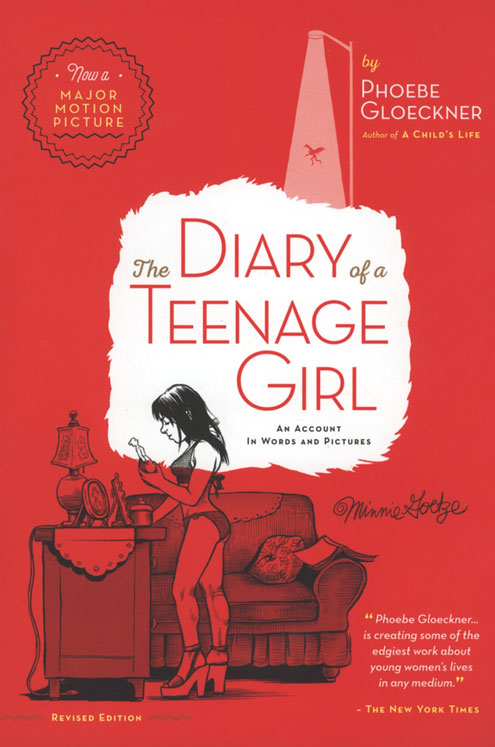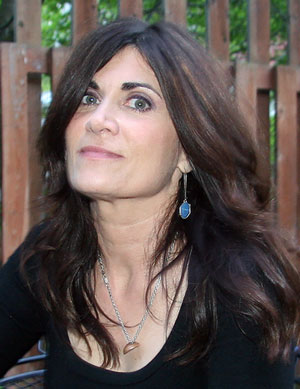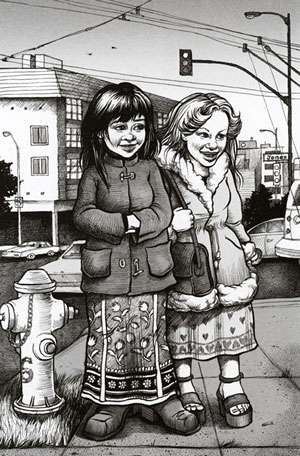
Drawing Power
Phoebe Gloeckner, author of “The Diary of a Teenage Girl,” the graphic novel that inspired a major motion picture, recalls the professor who encouraged her artistry.
I’m a cartoonist or a graphic novelist or, more precisely, an author who creates extended narratives with words and images. I’ve drawn and written comics since I was a teenager. I was fortunate to have grown up in the Bay Area, where great cartoonists like Robert Crumb, Diane Noomin and Spain Rodriguez lived and worked in the latter half of the 20th century.
When I got to college in the 1980s, however, I found that comics were not considered fine art by most, including some of my teachers at SF State, who strongly encouraged me not to “draw so illustratively” and not to “put boxes around my images.” In a sophomore painting class, I admitted to my professor, Jim Albertson, that I was tired because I’d been up all night finishing a page of comics for a punk tabloid. I hesitated, thinking he might say I was wasting my time. To my surprise, he was enthusiastic. “You do comics? I’d love to see them,” he said. I showed him my work, and he arranged for me to have a small solo show in the art school hallways. His interest in my art was validating. I’m no elitist when it comes to creativity — there are masters and masterworks in every genre, and to value painting or sculpture to the exclusion of comics made no sense to me. Albertson, the great painter and iconoclast that he was, shared my opinion.

Phoebe Gloeckner. Photo courtesy Phoebe Gloeckner.
I’ve written several books since my years in college. One of them, “The Diary of a Teenage Girl: An Account in Words and Pictures,” was released as a film earlier this year, adapted for the screen and directed by Marielle Heller. I’m a professor at the University of Michigan, but I traveled as often as possible to San Francisco to watch the film being shot. It was a surreal experience, a dreamy nightmare, as the book (and film) were derived from the diaries I wrote as an adolescent growing up in the city in the 1970s. Witnessing actors embodying the characters I had created, who were inspired by actual people in my life, was something like seeing ghosts, one of whom was myself.
My undergraduate education at SF State was an introduction to the larger world. I was able to study topics that may have seemed unrelated to my course of study but proved to have significant and fascinating connections. I took a course in aeronautical mapping and aviation charts, which left me feeling that I could navigate the universe. Later, I studied histology with the riveting Claude J. Coppenger, a large man with a Texas drawl who had done time as a Shakespearean actor. He would channel the peculiar characteristics of macrophages, spermatozoa and lysosomes and bring them to life before us, gesticulating and contorting his body, mimicking the behavior of these cells with unforgettable drama.

At SF State I developed my love of learning and began to discipline myself to achieve goals. I didn’t excel in high school, graduating by the skin of my teeth. It was my choice to go to college, and I accepted that my success or failure would depend solely on my efforts. To my surprise, I learned that I actually liked school. I was also able to backtrack a little. Although I was embarrassed at the time to admit it to friends, I took Algebra 1, a course I had failed three times as a high school freshman. By the end of the semester, I was amazed to realize that I loved math.
My imperfections as a student were hard to shake off completely. I didn’t finish my last semester and never completed my undergraduate degree, but by some combination of miracles, I went on to earn a graduate degree in Biomedical Communications (Medical Illustration) at the University of Texas. But despite my shortcomings, my education at SF State was invaluable. The people I met and the things I learned there formed the basis of my personal and professional trajectory. It’s a great university, and I was lucky to be there.